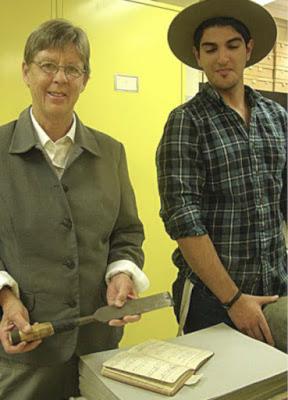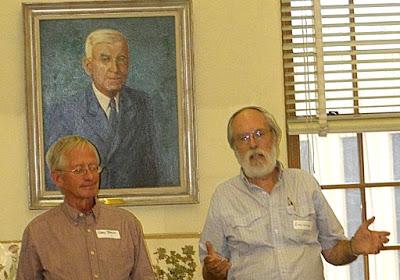
Mrs. Aven Nelson holds a “stout carpenter’s chisel” used to dig up plants in Yellowstone Park. Student assistant Leslie Goodding looks on. Between them are felt “blotters” for drying pressed plants.
Last week I was invited to do living history, also called historical reenactment. Fortunately, I accepted. I say “fortunately” because … it was somuchfun! It was like being kids again—when we could “be” cowboys, detectives, astronauts, explorers or whatever we wished! In this case, we were botanical explorers freshly returned from Yellowstone Park in 1899.The occasion was an open house at the Rocky Mountain Herbarium, University of Wyoming—celebrating 122 years of service to the botanical community, and the exciting prospects of expansion (at a time when we bemoan the closing of collections). Through demonstrations and exhibits, guests learned about plant collecting, specimen preparation, the value of herbaria, and the importance of our own herbarium. At a million specimens, it's the ninth largest in the US, and is the largest collection of Rocky Mountain plants.

Student intern mounts a pressed dried specimen on herbarium paper with white glue.Open house photos by B. Heidel, Wyoming Natural Diversity Database.

Botany Professor Greg Brown and Herbarium Manager Ernie Nelson describe a bright future for the Rocky Mountain Herbarium. Behind them Aven Nelson is listening, surely a happy man.
The Rocky Mountain Herbarium began as the vision of one man—Aven Nelson. Ironically, he was hired to teach English at the brand new University of Wyoming in 1887. There were only six faculty, yet somehow the Board of Trustees mistakenly hired two English professors. So Nelson’s career veered unexpectedly into biology, and then botany. It was long and illustrious, ending with his death in 1952 (age 93).In 1899, Nelson obtained permission from the US Army to collect plants in Yellowstone National Park. He, his family and two student assistants traveled by horse-draw wagon and camped out for 14 weeks, returning home with 30,000 specimens! (they recently wrote of their adventures in Botanists in Paradise). Most were duplicates, which were compiled into sets for exchange with herbaria around the world. Other sets were sold to herbaria and private collectors to raise money for field work. The Yellowstone project established the herbarium as a reputable and important institution, and the Board of Trustees of the University designated it the "Rocky Mountain Herbarium" that fall.At the open house, I had the privilege of being Mrs. Nelson. It was a special treat as I’ve been visiting with Aven Nelson’s grandson (97!), who grew up in his granddad’s house, and as a kid helped him with botany projects. It was great fun to tell Tom I would be his grandmother for a day. Ali, a history student, played 19-year old Leslie Goodding, one of the two student assistants.
Mrs. Nelson reviews a field book; Leslie Goodding shows his “catch” for the day—a vasculum full of plants ready to be pressed.

Leslie Goodding replacing blotters, near the end of the expedition. AHC.
The open house was a success—the herbarium was full of visitors. Mrs. Nelson and young Mr. Goodding had a steady audience for over an hour! They somehow managed to come up with a computer and slideshow of the photos that Professor Nelson took during the expedition—a convenient if puzzling convergence of the present and the past.[If you’re on a mobile device and can’t view the show, many of the old photos are here.]
